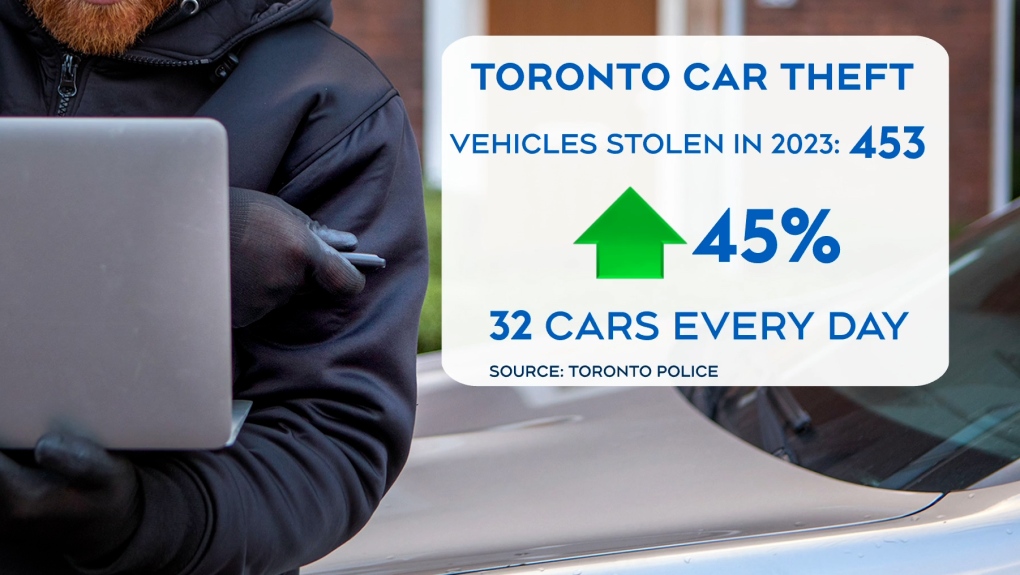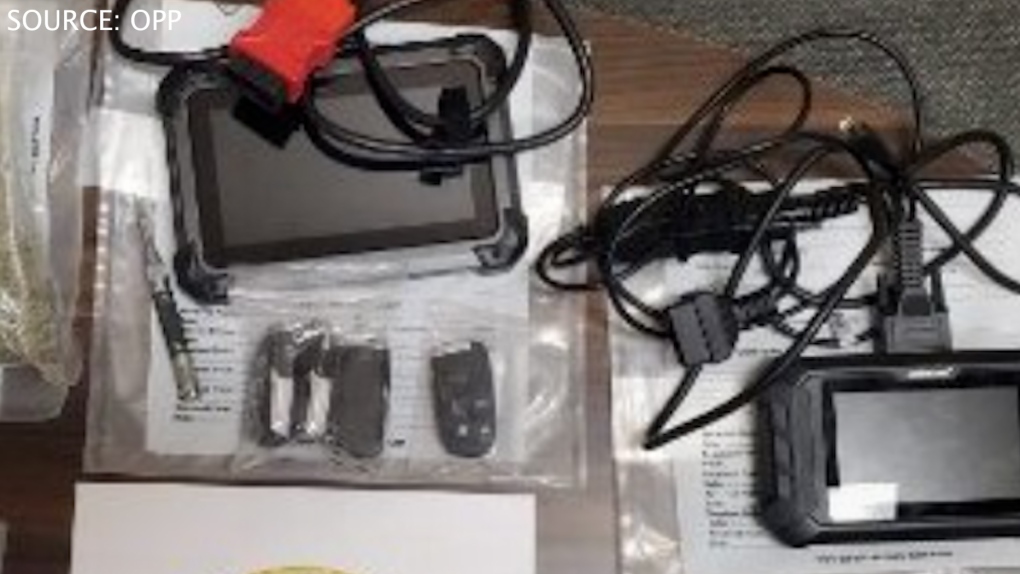New tricks leading to alarming rate of car thefts in Toronto
At least 32 cars have been stolen In Toronto each day so far in 2023, a surprising figure spurring calls for car manufacturers to catch up in a digital arms race with tech-savvy thieves.
Using a variety of tricks, like including portable devices that can access a car’s onboard computer, or tools that magnify a key fob’s signals, thieves can slip through digital defences and drive the cars away in minutes.
“I was shocked, to be honest with you,” Toronto man Zachary Kozak, whose Ram 1500 was stolen from his driveway this month, told CTV News Toronto.
Video from Kozak’s home shows two men disabling the horn on his truck, and the vehicle lights flashing silently. The thieves were able to access an onboard computer, allowing them to start the vehicle and drive away within seven minutes.
“They came in knowing what they wanted and knew exactly what they were doing,” Kozak said.
He said he’s frustrated because he believes he took reasonable security precautions, including using security cameras and keeping his key fob in a Faraday pouch, which blocks signals.
But it happened anyway. “Car manufacturers need to do more,” Kozak said.
In recent weeks, police in Ontario issued warnings about a rash of thefts of Ram trucks. In particular, Guelph, Waterloo, Brantford and South Simcoe have been targeted, police said.
In Toronto, police said the first two weeks of 2023 saw 453 vehicle thefts reported, a 48 per cent increase over the same period last year — an amount that surged to 32 a day.

In 2022, Toronto police reported 9,594 vehicles stolen, compared to 6,601 the previous year. Police responded with major operations like Project Touchdown, which seized 200 vehicles, and intercepted illegal guns and drugs, returning some $17 million from alleged organized criminals.
The increase has been widely felt in many parts of the country, said South Simcoe Police Service Staff Sgt. Dave Phillips.
“It appears the thieves have become very sophisticated. These vehicles have more modern comfort features that us, as drivers, enjoy, and it appears that these thieves have found a way to manipulate that piece of technology in their favour,” he said.
The technology tricks are one of several employed by thieves, who have traded a crowbar for portable devices, that can access a car through its onboard diagnostic port and reprogram it so that it recognizes a new key — the approach that appears to have worked with Kozak’s truck.
Another method is a relay attack, where thieves approach someone’s door with a wire designed to sense the signal from a key fob, amplify it, and trick the car into believing the owner’s key is inside the vehicle so it can be started.
Some Kias and Hyundais were so easy to steal that an American class-action lawsuit claims it became a challenge on the social media site TikTok.
 New tech can now trick a car into believing the owner’s key is inside the vehicle (OPP).
New tech can now trick a car into believing the owner’s key is inside the vehicle (OPP).
“The Kia challenge,” Buffalo Police Department Commissioner Joseph Gramaglia said last year. “They are easy, unfortunately, to steal.”
Cybersecurity expert Cladiu Popa told CTV News Toronto car companies need have better protections to defend against these thefts. Popa said companies need to add measures to defeat them, as well as infrastructure that can nimbly defeat future attacks, just like how computer operating systems are constantly downloading patches.
“One of the key issues today, is manufacturers are not keeping up with security vulnerabilities. That much is clear,” Popa said.
Some measures that have proven successful in the computer realm are passwords and dual authentication, he said, and car companies need to be thinking in that way.
“These are computers on wheels,” he said.
Stellantis, which makes the Ram, said it’s rolling out a new suite of security measures that will make it harder to clone key fobs and also include a feature that allows the vehicle owner to require a passcode for the vehicle to go faster than a certain speed.
Those measures are already in place for the Charger and the Challenger models, as every company attempts to improve features for what can be diverse and varied platforms on each car.
“We use industry standard technology. As with other vehicle features, we are engaged in continuous product improvement,” Stellantis said in a statement.
Those measures have yet to be imposed on the Ram model, which could explain why thieves appear to be targeting that model around Ontario.
Security shouldn’t be optional, said Kozak, who doesn’t want other vehicle owners to watch their cars drive away without them.
“I feel car manufacturers should do more,” he said.
CTVNews.ca Top Stories

opinion Tom Mulcair: Prime Minister Justin Trudeau's train wreck of a final act
In his latest column for CTVNews.ca, former NDP leader and political analyst Tom Mulcair puts a spotlight on the 'spectacular failure' of Prime Minister Justin Trudeau's final act on the political stage.
B.C. mayor gets calls from across Canada about 'crazy' plan to recruit doctors
A British Columbia community's "out-of-the-box" plan to ease its family doctor shortage by hiring physicians as city employees is sparking interest from across Canada, says Colwood Mayor Doug Kobayashi.
'There’s no support': Domestic abuse survivor shares difficulties leaving her relationship
An Edmonton woman who tried to flee an abusive relationship ended up back where she started in part due to a lack of shelter space.
Baseball Hall of Famer Rickey Henderson dead at 65, reports say
Rickey Henderson, a Baseball Hall of Famer and Major League Baseball’s all-time stolen bases leader, is dead at 65, according to multiple reports.
Arizona third-grader saves choking friend
An Arizona third-grader is being recognized by his local fire department after saving a friend from choking.
Germans mourn the 5 killed and 200 injured in the apparent attack on a Christmas market
Germans on Saturday mourned the victims of an apparent attack in which authorities say a doctor drove into a busy outdoor Christmas market, killing five people, injuring 200 others and shaking the public’s sense of security at what would otherwise be a time of joy.
Blake Lively accuses 'It Ends With Us' director Justin Baldoni of harassment and smear campaign
Blake Lively has accused her 'It Ends With Us' director and co-star Justin Baldoni of sexual harassment on the set of the movie and a subsequent effort to “destroy' her reputation in a legal complaint.
Oysters distributed in B.C., Alberta, Ontario recalled for norovirus contamination
The Canadian Food Inspection Agency has issued a recall due to possible norovirus contamination of certain oysters distributed in British Columbia, Alberta and Ontario.
New rules clarify when travellers are compensated for flight disruptions
The federal government is proposing new rules surrounding airlines' obligations to travellers whose flights are disrupted, even when delays or cancellations are caused by an "exceptional circumstance" outside of carriers' control.


































